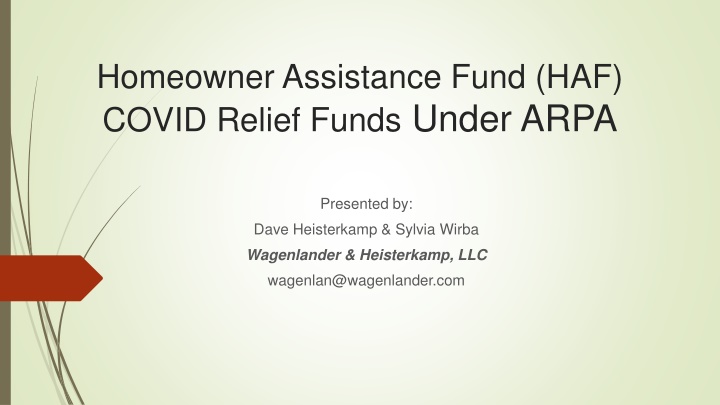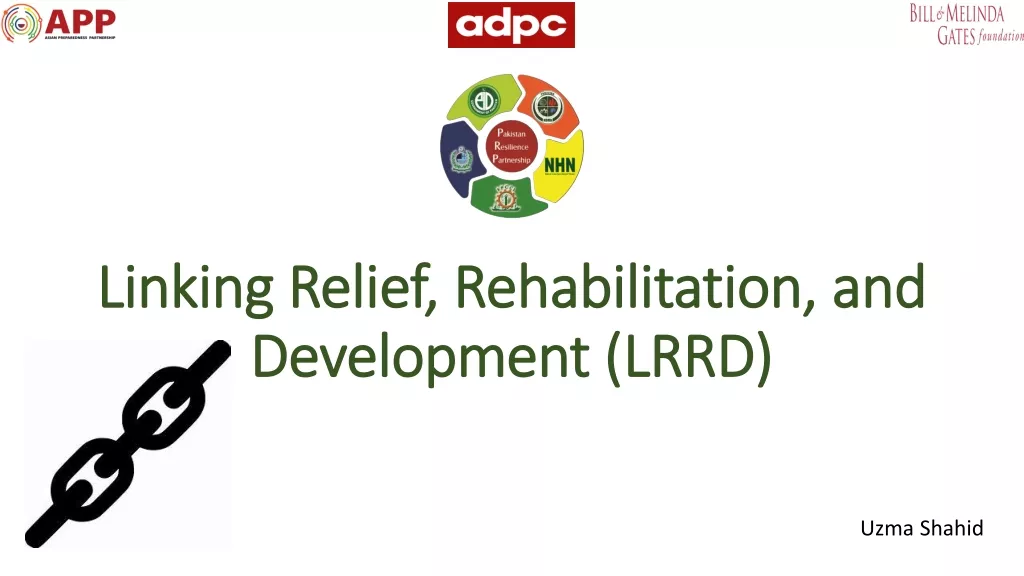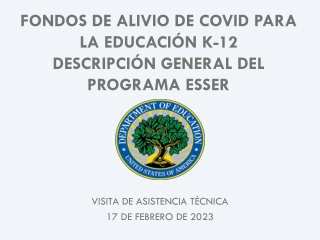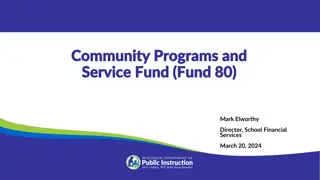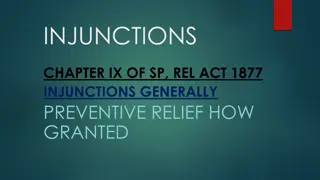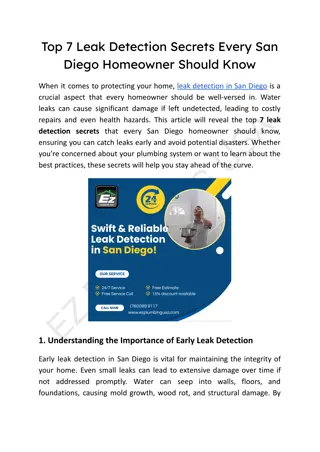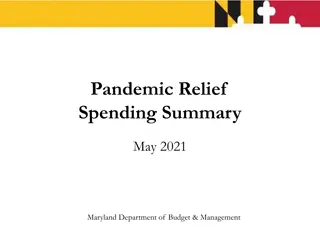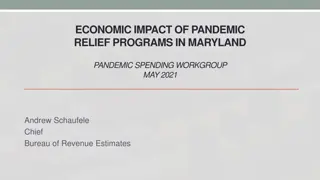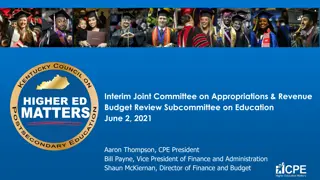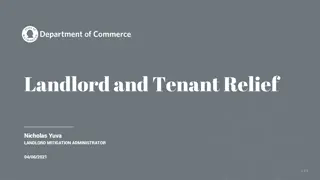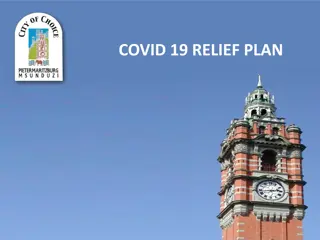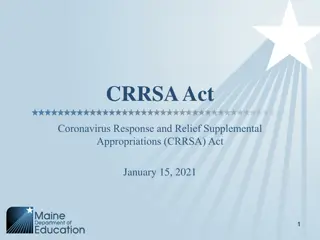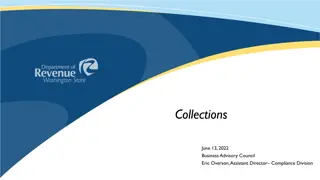Homeowner Assistance Fund (HAF) COVID Relief Fund Overview
The Homeowner Assistance Fund (HAF) under the American Rescue Plan Act (ARPA) provides financial assistance to eligible homeowners who have experienced financial hardships. The funds can be used for mortgage payment assistance, reinstating a mortgage, or other housing-related costs. Eligible homeowners must meet specific income criteria and attest to their financial hardships. Learn more about the HAF eligibility, allowable uses, and application process.
Download Presentation

Please find below an Image/Link to download the presentation.
The content on the website is provided AS IS for your information and personal use only. It may not be sold, licensed, or shared on other websites without obtaining consent from the author.If you encounter any issues during the download, it is possible that the publisher has removed the file from their server.
You are allowed to download the files provided on this website for personal or commercial use, subject to the condition that they are used lawfully. All files are the property of their respective owners.
The content on the website is provided AS IS for your information and personal use only. It may not be sold, licensed, or shared on other websites without obtaining consent from the author.
E N D
Presentation Transcript
Homeowner Assistance Fund (HAF) COVID Relief Funds Under ARPA Presented by: Dave Heisterkamp & Sylvia Wirba Wagenlander & Heisterkamp, LLC wagenlan@wagenlander.com
Homeowner Assistance Fund 2 American Rescue Plan Act (ARPA) - Public Law 117-2, enacted March 11, 2021 Funds remain available until September 30, 2025 Homeowner Assistance Fund (HAF) Administered by U.S. Dept. of Treasury Webpage: https://home.treasury.gov/policy-issues/coronavirus/assistance- for-state-local-and-tribal-governments/homeowner-assistance-fund Notice of Request to Receive Payments (due 11/15/21 for Tribes/TDHEs) The ARPA requires eligible entities to notify Treasury of their request to receive payment from the HAF Treasury has published a notice of funds request form, which must be completed, signed by an authorized official of the eligible entity, and returned to Treasury available at the webpage listed above Wagenlander & Heisterkamp, LLC October, 2021
Homeowner Assistance Fund 3 Financial Assistance Agreement (due when funds are requested) Each eligible entity approved to receive payment from the HAF must enter into a financial assistance agreement with Treasury. A form for the financial assistance agreement is available at the webpage listed previously. Initial disbursement of 10% of grant amount Treasury encourages HAF participants to create or fund pilot programs with initial disbursement 50% of 10% may be used for planning, community engagement, needs assessment, and administrative expenses. Wagenlander & Heisterkamp, LLC October, 2021
HAF - Eligible Homeowners 4 experienced a financial hardship after January 21, 2020 (including a hardship that began before January 21, 2020, but continued after that date) have incomes equal to or less than 150% of the area median income or 100% of the median income for the United States, whichever is greater. HAF funds can only be paid to a homeowner with respect to qualified expenses related to the dwelling that is such homeowner s primary residence. homeowners must attest that they experienced financial hardship after January 21, 2020. The attestation must describe the nature of the financial hardship (for example, job loss, reduction in income, or increased costs due to healthcare or the need to care for a family member). tribes or TDHEs can provide assistance to members, or individuals otherwise eligible for HAF, who reside outside the tribal government s geographic jurisdiction. Tribal authorities should confirm that any such assistance can be provided consistently with the tribe s constitution and governing law. Wagenlander & Heisterkamp, LLC October, 2021
5 Homeowner Assistance Fund (HAF) Allowable Uses Mortgage payment assistance. Financial assistance to allow a homeowner to reinstate a mortgage or to pay other housing-related costs related to a period of forbearance, delinquency, or default. Mortgage principal reduction, including with respect to a second mortgage provided by a nonprofit or government entity. Facilitating mortgage interest rate reductions. Wagenlander & Heisterkamp, LLC October, 2021
Homeowner Assistance Fund (HAF) Allowable Uses (cont d.) Payment assistance for: a) Homeowner s utilities, including electric, gas, home energy, and water. b) Homeowner s internet service, including broadband internet access service. c) Homeowner s insurance, flood insurance, and mortgage insurance. d) Homeowner s association fees or liens, condominium association fees, or common charges. e) Down payment assistance loans provided by nonprofit or government entities.
Homeowner Assistance Fund (HAF) Allowable Uses (cont d.) 7 Payment assistance for delinquent property taxes to prevent homeowner tax foreclosures. Measures to prevent homeowner displacement, such as home repairs to maintain the habitability of a home or assistance to enable households to receive clear title to their properties. Counseling or educational efforts by housing counseling agencies approved by HUD, or legal services, targeted to households eligible to be served with funding from the HAF related to foreclosure prevention or displacement, in an aggregate amount up to 5% of the funding from the HAF received by the HAF participant. Wagenlander & Heisterkamp, LLC October, 2021
Homeowner Assistance Fund (HAF) Allowable Uses (cont d.) Reimbursement of funds expended by a state, local government, or entity described in clause (3) or (4) of the definition above of eligible entity during the period beginning on January 20, 2020, and ending on the date that the first funds are disbursed by the HAF participant under the HAF, for a qualified expense (other than any qualified expense paid directly or indirectly by another federal funding source or any qualified expenses described in clauses (6), (7), (8), or (10) of this definition). Planning, community engagement, needs assessment and administrative expensesrelated to the HAF participant s disbursement of HAF funds for qualified expenses, in an aggregate amount not to exceed 15% of the HAF received by the HAF participant.
HAF Plan 9 Updated HAF Guidance issued August 2, 2021 Available here: https://home.treasury.gov/system/files/136/HAF-Guidance.pdf HAF Plan (no specific due date for TDHEs) Templates for grantees under and over $5M have been published and include the required budget templates and are available on the webpage A grantee may elect to submit a single, comprehensive HAF plan that describes the intended uses for the participant s entire HAF allocation, or multiple, partial HAF plans that each describe only a portion of the intended uses for the participant s allocation. Submission of partial HAF plans may allow grantees to proceed more quickly to implement portions of their plan while conducting planning and community engagement for other planned activities. Individual activities will be described in Term Sheets Treasury has provided several sample Term Sheets for grantees at the webpage Wagenlander & Heisterkamp, LLC October, 2021
HAF Plan (contd) 10 HAF Plan Assessment and Approval (by Treasury) Once the HAF Plan is submitted, Treasury will review the plan. Treasury will evaluate HAF Plans as described in the HAF guidance. Treasury may approve a HAF Plan in whole or in part. If Treasury identifies weaknesses in any elements of your HAF Plan, the grantee will be provided an opportunity to revise and resubmit those elements. Upon Treasury s approval of the HAF Plan, Treasury will initiate steps to transmit the requested allocation amount. Reporting and Monitoring Sanctions All HAF Plans MUST be submitted through the online portal Wagenlander & Heisterkamp, LLC October, 2021
Homeowner Assistance Fund Plan Components 11 Treasury has provided a streamlined template for grantees receiving under $5M HAF grant only 15 Tribes/TDHEs are over $5M nationwide. HAF plan templates are available on the webpage In the event that the information required in the HAF plan is not available to a tribe, Treasury will accept alternative information regarding the relevant community. Homeowner Needs and Engagement Program Descriptions / Term Sheets Wagenlander & Heisterkamp, LLC October, 2021
HAF Plan Components (contd.) Methods of Targeting HAF Funding A HAF plan submitted by a tribe whose population consists largely or entirely of socially disadvantaged individuals may be tailored to reflect the limited effort necessary to target its programs for those individuals. Best Practices in Coordination with Other HAF Participants Performance Goals Readiness Staffing and Systems Contracts and Partnerships Existing and Pilot Programs Budget required template is part of Plan template
13 Wagenlander & Heisterkamp, LLC October, 2021
14 Wagenlander & Heisterkamp, LLC October, 2021
15 Wagenlander & Heisterkamp, LLC October, 2021
16 Wagenlander & Heisterkamp, LLC October, 2021
Program Descriptions or Term Sheets 17 HAF participants must describe each program for which they will use HAF funding. Treasury has provided sample Term Sheets for this purpose. The description must describe the targeted population of homeowners and the financial challenges the program would address based on the data-driven assessment of homeowner needs (e.g., the immediate challenge of mortgage delinquency, or displacement prevention). Wagenlander & Heisterkamp, LLC October, 2021
Program Descriptions or Term Sheets (cont d) 18 Each program description/term sheet must include a description of: eligibility requirements; the intended impact on eligible homeowners; the application process; conditions or limitations -- including the maximum dollar amount that the program will provide to each homeowner for each type of qualified expense; a description of the payment process; other available sources of assistance for targeted homeowners Wagenlander & Heisterkamp, LLC October, 2021
Program Descriptions or Term Sheets (cont d) 19 HAF participants must have one or more programs intended to reduce mortgage delinquency among targeted populations. Treasury encourages HAF participants to consider homeownership preservation programs for low-income households in areas where property taxes and utility costs are increasing, including for households that do not have mortgages. Treasury also encourages HAF participants to consider program designs that leverage utility assistance from other federal programs that have been created expressly for that purpose before using HAF funds for utility assistance. Wagenlander & Heisterkamp, LLC October, 2021
20 Wagenlander & Heisterkamp, LLC October, 2021
21 Wagenlander & Heisterkamp, LLC October, 2021
22 Wagenlander & Heisterkamp, LLC October, 2021
23 Wagenlander & Heisterkamp, LLC October, 2021
24 Wagenlander & Heisterkamp, LLC October, 2021
HAF Plan Assessments and Approvals 25 Treasury will assess HAF plans based on the following factors: Alignment of Community Needs and Program Design: The extent to which programs are responsive to community needs and based on a best practice model or evidence of the HAF participant s effective implementation of a previous program or pilot program. Alignment of Performance Goals with Data on Targeted Populations: The extent to which the performance goals would address the needs of specific eligible populations within targeted communities, in a manner that is appropriate to the jurisdiction. Methods of Targeting: The extent to which the HAF participant describes targeting methods reasonably likely to result in HAF assistance being made available to eligible homeowners consistent with the targeting requirements described in the ARP and in applicable guidance issued by Treasury. Wagenlander & Heisterkamp, LLC October, 2021
HAF Plan Assessments and Approvals (cont d) 26 Readiness: The extent to which the HAF participant demonstrates readiness to implement a program at scale, including having in place policies and procedures (refer to the Term Sheet) for the program and an appropriate mix of staffing, contractors, and partners. Implementation of a pilot program or pre-existing program that successfully targeted resources to the targeted populations will be a strong indication of readiness. Alignment of Budget with Performance Goals: The extent to which the funding budgeted by program reasonably supports the achievement of the performance goals. Wagenlander & Heisterkamp, LLC October, 2021
Share Success! 27 When your TDHE has effectively used the funding from a particular program, share positive outcomes with everyone. (Tribe, State, Federal Agency, Senators, House Representatives, etc.) Great track records will create incentives for possible other federal assistance or more $$$ in the future. Indian housing Need is still there. But when given the opportunity to address Need, TDHEs can be, and are, successful. Wagenlander & Heisterkamp, LLC October, 2021
Questions & Answers (an open discussion) Wagenlander & Heisterkamp, LLC Attorneys at Law Denver, Colorado (303) 832-6511 wagenlan@wagenlander.com
